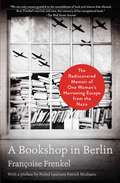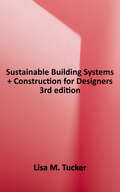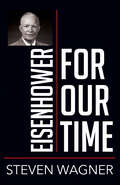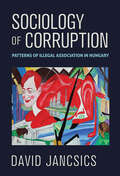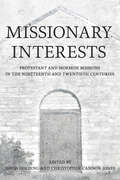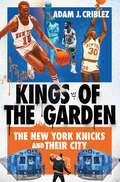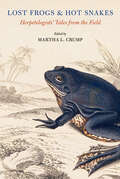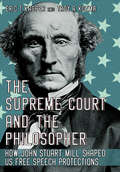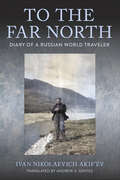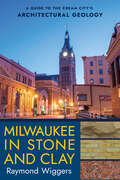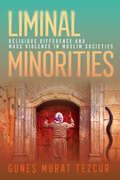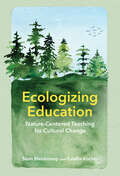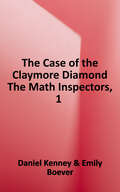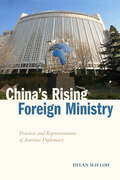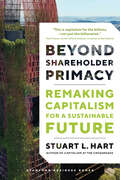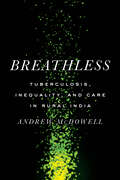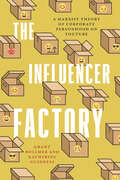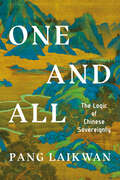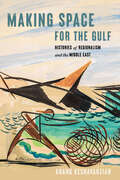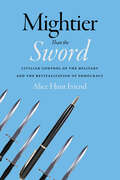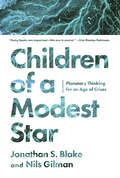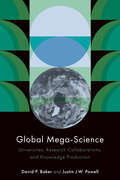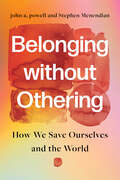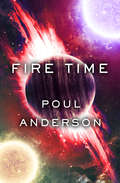- Table View
- List View
A Bookshop in Berlin: The Rediscovered Memoir of One Woman's Harrowing Escape from the Nazis
by Françoise FrenkelA PEOPLE BOOK OF THE WEEKWINNER OF THE JQ–WINGATE LITERARY PRIZE&“A haunting tribute to survivors and those lost forever—and a reminder, in our own troubled era, never to forget.&” —PeopleAn &“exceptional&” (TheWall Street Journal) and &“poignant&” (TheNew York Times) book in the tradition of rediscovered works like SuiteFrançaise and The Nazi Officer&’s Wife, the powerful memoir of a fearless Jewish bookseller on a harrowing fight for survival across Nazi-occupied Europe.In 1921, Françoise Frenkel—a Jewish woman from Poland—fulfills a dream. She opens La Maison du Livre, Berlin&’s first French bookshop, attracting artists and diplomats, celebrities and poets. The shop becomes a haven for intellectual exchange as Nazi ideology begins to poison the culturally rich city. In 1935, the scene continues to darken. First come the new bureaucratic hurdles, followed by frequent police visits and book confiscations. Françoise&’s dream finally shatters on Kristallnacht in November 1938, as hundreds of Jewish shops and businesses are destroyed. La Maison du Livre is miraculously spared, but fear of persecution eventually forces Françoise on a desperate, lonely flight to Paris. When the city is bombed, she seeks refuge across southern France, witnessing countless horrors: children torn from their parents, mothers throwing themselves under buses. Secreted away from one safe house to the next, Françoise survives at the heroic hands of strangers risking their lives to protect her. Published quietly in 1945, then rediscovered nearly sixty years later in an attic, A Bookshop in Berlin is a remarkable story of survival and resilience, of human cruelty and human spirit. In the tradition of Suite Française and The Nazi Officer&’s Wife, this book is the tale of a fearless woman whose lust for life and literature refuses to leave her, even in her darkest hours.
Sustainable Building Systems and Construction for Designers: Bundle Book + Studio Access Card, Third edition
by Lisa M. TuckerAuthor Lisa M. Tucker covers topics in a holistic approach, from the structural (site consideration and foundations) to the experiential (indoor air, acoustics, and safety), making a clear case for interior design professionals to understand their moral responsibilities to people and the environment, and to follow sustainable building practices. Now in its third edition, the award-winning Sustainable Building Systems and Construction for Designers has been updated to reflect current CIDA accreditation standards and include recent industry trends related to interior construction, such as security and well-being. Additionally, a complete set of new case studies has been commissioned. Line drawings, color photography, and sample student work join together to support student learning on this essential and timely topic. New to this Edition: -Updated with CIDA Standards 2018 -Expanded content on security, resilience, plumbing, and well-being design trends -Complete set of 7 new case studies -First edition to include STUDIO with self-assessment questions and flashcards and Instructor Resources including an instructor's guide and PowerPoint slides
Art And Architecture Of The Middle Ages: Exploring A Connected World
by Jill Caskey Adam S. Cohen Linda SafranArt and Architecture of the Middle Ages is a panoramic survey that focuses on the arts of medieval Europe, Byzantium, and the Islamicate world. From majestic monuments to exquisite tableware, Jill Caskey, Adam S. Cohen, and Linda Safran deftly guide readers over twelve centuries of art and architecture created by the diverse peoples and religious groups of western Eurasia and North Africa. This textbook, intended for a wide range of courses in the history of medieval art and architecture, uniquely features: • More than 450 color illustrations of fascinating works produced between ca. 250 CE and ca. 1450 CE • Coverage of secular and religious arts, including polytheistic, Zoroastrian, Jewish, Christian, and Islamic traditions • Informational text boxes on key issues and a glossary of terms • Diverse cultures interwoven in a single chronological framework • Five broad interpretive themes―artistic production, status and identity, connection to the past, ideology, and access to the sacred Complemented by a website (artofthemiddleages.com) with additional works, dynamic maps and timelines, podcasts, new primary-source translations, and more, Art and Architecture of the Middle Ages brilliantly expands and recalibrates the story of medieval art history.
Eisenhower for Our Time (People for Our Time)
by Steven WagnerEisenhower for Our Time provides an introduction to the Eisenhower presidency, extracting lessons for today's world. Steven Wagner proposes that the need to maintain balance defines Eisenhower's presidency. Wagner examines a series of defining moments that were among Eisenhower's greatest challenges, some of which resulted in his greatest accomplishments: the decision to run for president, his political philosophy of the "Middle Way," the creation of a national security policy, the French Indochina War, Senator Joseph McCarthy, the Little Rock Desegregation Crisis, the Race for Space, and the famous Farewell Address. Wagner looks at Eisenhower's executive ability, leadership, decision making, and willingness to compromise, as well as the qualities of duty, integrity, and good character. The moments detailed in Eisenhower for Our Time show Eisenhower as a president intimately engaged in the decisions that defined America in his time and that apply to ours today. The President's actions place him among the most successful presidents and provide many lessons to guide us in our time and in the future.
Sociology of Corruption: Patterns of Illegal Association in Hungary
by David JancsicsIn Sociology of Corruption, David Jancsics provides a fresh approach to the study of corruption in Hungary, which once seemed to be the most likely of the ex-communist bloc nations to catch up to the West and is, according to many experts and scholars, a country with a highly corrupt dynamic.Based on data from 2022, Hungary is now the most corrupt member state of the European Union. There is also a consensus among experts that a small clique of corrupt political actors has captured most Hungarian state institutions and a significant portion of the business sector. What fostered corruption in Hungary? What are the most typical forms of corruption in this country? What do Hungarians think about it? What is the role of prime minister Viktor Orbán in this? Sociology of Corruption proposes a novel sociological theory of corruption focusing on social status and relationships, network structures, and power dynamics as important explanatory factors of corrupt behavior. Although his focus is on Hungary, Jancsics's findings are applicable to other nations and cultural contexts.
Missionary Interests: Protestant and Mormon Missions of the Nineteenth and Twentieth Centuries
by Edited by David Golding and Christopher Cannon JonesIn Missionary Interests, David Golding and Christopher Cannon Jones bring together works about Protestant and Mormon missionaries in the nineteenth and twentieth centuries, charting new directions for the historical study of these zealous evangelists for their faith. Despite their sectarian differences, both groups of missionaries shared notions of dividing the world categorically along the lines of race, status, and relative exoticism, and both employed humanitarian outreach with designs to proselytize.American missionaries occupied liminal spaces: between proselytizer and proselytized, feminine and masculine, colonizer and colonized. Taken together, the chapters in Missionary Interests dismantle easy characterizations of missions and conversion and offer an overlooked juxtaposition between Mormon and Protestant missionary efforts in the nineteenth and twentieth centuries.
Kings of the Garden: The New York Knicks and Their City
by Adam J. CriblezIn Kings of the Garden, Adam J. Criblez traces the fall and rise of the New York Knicks between the 1973, the year they won their last NBA championship, and 1985, when the organization drafted Patrick Ewing and gave their fans hope after a decade of frustrations. During these years, the teams led by Walt Frazier, Earl Monroe, Bob McAdoo, Spencer Haywood, and Bernard King never achieved tremendous on-court success, and their struggles mirrored those facing New York City over the same span. In the mid-seventies, as the Knicks lost more games than they won and played before smaller and smaller crowds, the city they represented was on the brink of bankruptcy, while urban disinvestment, growing income inequality, and street gangs created a feeling of urban despair. Kings of the Garden details how the Knicks' fortunes and those of New York City were inextricably linked. As the team's Black superstars enjoyed national fame, Black musicians, DJs, and B-boys in the South Bronx were creating a new culture expression—hip-hop—that like the NBA would become a global phenomenon. Criblez's fascinating account of the era shows that even though the team's efforts to build a dynasty ultimately failed, the Knicks, like the city they played in, scrappily and spectacularly symbolized all that was right—and wrong—with the NBA and the nation during this turbulent, creative, and momentous time.
Lost Frogs and Hot Snakes: Herpetologists' Tales from the Field
by Martha L. CrumpLost Frogs and Hot Snakes reveals the thrills and travails that herpetologists experience when working with amphibians and reptiles in the wild. With essays from fifty field biologists, this volume, edited by Martha L. Crump, presents a multifaceted yet intimate look at life in pursuit of knowledge about the natural world. From the beaches of Peru to the mountains of China, the stories in this collection place readers in the boots of field biologists as they watch, count, experiment, and survey. Some recall mishaps and misadventures—contending with leeches, dangling off a precipice while in a truck. Others tell of once-in-a-lifetime encounters—discovering a new frog species, spotting a rare snake. Together, these stories offer an understanding of what field biology is, what field biologists do, and how they go about doing it. Written with candor, warmth, and a dash of humor, the stories in Lost Frogs and Hot Snakes will encourage readers to appreciate the value of engaging with nature and of the amphibians and reptiles so critical to the vitality of our planet.
The Supreme Court and the Philosopher: How John Stuart Mill Shaped US Free Speech Protections
by Eric T. Kasper Troy A. KozmaThe Supreme Court and the Philosopher illustrates how the modern US Supreme Court has increasingly adopted a view of the constitutional right to the freedom of expression that is classically liberal in nature, reflecting John Stuart Mill's reasoning in On Liberty. A landmark treatise outlining the merits of limiting governmental and social power over the individual, On Liberty advocates for a maximum protection of human freedom. Proceeding case by case and covering a wide array of issues, such as campaign finance, offensive speech, symbolic speech, commercial speech, online expression, and false statements, Eric T. Kasper and Troy A. Kozma show how the Supreme Court justices have struck down numerous laws for infringing on the freedom of expression.Kasper and Kozma demonstrate how the adoption of Mill's version of free speech began with Justice Oliver Wendell Holmes Jr. more than a century ago and expanded over time to become the prevailing position of the Court today. The authors argue that this embrace of Mill's rationale has led to an unmistakable reorientation in the Court's understanding of free expression jurisprudence.The Supreme Court and the Philosopher is the first book to comprehensively explore how the political philosophy of Mill has influenced the highest court in the land. In targeting the underlying philosophical reasons that explain why the modern Supreme Court renders its First Amendment decisions, this book is particularly timely, as the issues of censorship and freedom of expression are debated in the public square today.
To the Far North: Diary of a Russian World Traveler (NIU Series in Slavic, East European, and Eurasian Studies)
by Ivan Nikolaevich Akif’ëvThis annotated translation of To the Far North presents the diary of a twenty-seven-year-old Russian physician who was part of the 1900 expedition to the Chukotka Peninsula to find gold. No other account so richly details life along the North Pacific Rim before World War I, especially from a Russian perspective. This volume relates the expedition's formation, development, and aftermath and offers unique insights on the region's place in both Russian policymaking and geopolitics. The illustrated diary includes picturesque descriptions of San Francisco, the Nome Gold Rush, Chukchi culture, Petropavlovsk, Vladivostok, and Nagasaki, Japan.Andrew A. Gentes's translation is based on an edition of Akifëv's book that was published in St. Petersburg in 1904. The diary shows how Russian and American views and cultural values clashed over a territory that is today more geopolitically important than ever. By documenting Akifëv's personal travels outside the expedition, To the Far North also demonstrates, in both human and personal terms, the role Russians played in shaping this region's history.
Milwaukee in Stone and Clay: A Guide to the Cream City's Architectural Geology
by Raymond WiggersMilwaukee in Stone and Clay follows directly in the footsteps of Raymond Wiggers's previous award-winning book, Chicago in Stone and Clay. It offers a wide-ranging look at the fascinating geology found in the building materials of Milwaukee County's architectural landmarks. And it reveals the intriguing and often surprising links between science, art, and engineering. Laid out in two main sections, the book first introduces the reader to the fundamentals of Milwaukee's geology and its amazing prehuman history, then provides a site-by-site tour guide. Written in an engaging, informal style, this work presents the first in-depth exploration of the interplay among the region's most architecturally significant sites, the materials they're made of, and the sediments and bedrock they're anchored in. Raymond Wiggers crafted Milwaukee in Stone and Clay as an informative and exciting overview of this city. His two decades of experience leading architectural-geology tours have demonstrated the popularity of this approach and the subject matter.
Liminal Minorities: Religious Difference and Mass Violence in Muslim Societies (Religion and Conflict)
by Günes Murat TezcürLiminal Minorities addresses the question of why some religious minorities provoke the ire of majoritarian groups and become targets of organized violence, even though they lack significant power and pose no political threat. Güneş Murat Tezcür argues that these faith groups are stigmatized across generations, as they lack theological recognition and social acceptance from the dominant religious group. Religious justifications of violence have a strong mobilization power when directed against liminal minorities, which makes these groups particularly vulnerable to mass violence during periods of political change.Offering the first comparative-historical study of mass atrocities against religious minorities in Muslim societies, Tezcür focuses on two case studies—the Islamic State's genocidal attacks against the Yezidis in northern Iraq in the 2010s and massacres of Alevis in Turkey in the 1970s and 1990s—while also addressing discrimination and violence against followers of the Bahá'í faith in Iran and Ahmadis in Pakistan and Indonesia. Analyzing a variety of original sources, including interviews with survivors and court documents, Tezcür reveals how religious stigmatization and political resentment motivate ordinary people to participate in mass atrocities.
Ecologizing Education: Nature-Centered Teaching for Cultural Change
by Sean Blenkinsop Estella C. KuchtaEcologizing Education explores how we can reenvision education to meet the demands of an unjust and rapidly changing world. Going beyond "green" schooling programs that aim only to shape behavior, Sean Blenkinsop and Estella Kuchta advance a pedagogical approach that seeks to instills eco-conscious and socially just change at the cultural level. Ecologizing education, as this approach is called, involves identifying and working to overcome anti-ecological features of contemporary education. This approach, called ecologizing education, aims to develop a classroom culture in sync with the more-than-human world where diversity and interdependency are intrinsic.Blenkinsop and Kuchta illustrate this educational paradigm shift through the real-world stories of two public elementary schools located in British Columbia. They show that this approach to learning starts with recognizing the environmental and social injustices that pervade our industrialized societies. By documenting how ecologizing education helps children create new relationships with the natural world and move toward mutual healing, Blenkinsop and Kuchta offer a roadmap for what may be the most potent chance we have at meaningful change in the face of myriad climate crises. Timely, practical, and ultimately inspirational, Ecologizing Education is vital reading for any parent, caregiver, environmentalist, or educator looking for wholistic education that places nature and the environment front and center.
The Math Inspectors: Story One - The Case of the Claymore Diamond (The\math Inspectors Ser.)
by Daniel Kenney Emily BoeverEach book in this insanely popular mystery & detective series is designed to draw readers aged 9-12 into a mystery so intriguing, with characters so smart and funny, that they forget they're doing math. Because the Math Inspectors know two things. First, math is the greatest thing in the world. Second, crime-solving is nothing more than a word problem. And they eat word problems for breakfast!
China's Rising Foreign Ministry: Practices and Representations of Assertive Diplomacy (Studies in Asian Security)
by Dylan M.H LohChina's rise and its importance to international relations as a discipline-defining phenomenon is well recognized. Yet when scholars analyze China's foreign relations, they typically focus on Beijing's military power, economic might, or political leaders. As a result, most traditional assessments miss a crucial factor: China's Ministry of Foreign Affairs (MOFA). In China's Rising Foreign Ministry, Dylan M.H Loh upends conventional understandings of Chinese diplomacy by underlining the importance of the ministry and its diplomats in contemporary Chinese foreign policy. Loh explains how MOFA gradually became the main interface of China's foreign policy and the primary vehicle through which the idea of 'China' is produced, articulated, and represented on the world stage. This theoretically innovative and ambitious book offers an original reading of Chinese foreign policy, with wide-ranging implications for international relations. By shedding light on the dynamics of Chinese diplomacy and how assertiveness is constructed, Loh provides readers with a comprehensive re-appraisal of China's foreign ministry and the role it performs in China's re-emergence.
Beyond Shareholder Primacy: Remaking Capitalism for a Sustainable Future
by Stuart HartFrom the author of Capitalism at the Crossroads, a call to consciousness—and action—for individuals, organizations, communities, and nations. Our current Milton Friedman–style "shareholder primacy capitalism," as taught in business schools and embraced around the world, has become dangerous for society, the climate, and the planet. Moreover, Stuart L. Hart argues, it's economically unnecessary. But there are surprising reasons for hope—from the history of capitalism itself. Beyond Shareholder Primacy argues that capitalism has reformed itself twice before and is poised for a third major reformation. Retelling the origin story of capitalism from the fifteenth century to the present, Hart argues that a radically sustainable, just capitalism is possible, and even likely, in our lifetime. Hart goes on to describe what it will take to move beyond capitalism's present worship of "shareholder primacy," including corporate transformations to re-embed purpose and reforms to major economic institutions. A key requirement is eliminating the "externalities" (or collateral damage) of our current shareholder capitalism. Sustainable capitalism will explicitly incorporate the needs of society and the planet, include a financial system that allows leaders to prioritize the planet, reorganize business schools around sustainable management thinking, and enable corporations not just to stop ignoring the damage they cause, but actually begin to create positive impact.
Breathless: Tuberculosis, Inequality, and Care in Rural India (South Asia in Motion)
by Andrew McDowellEach year in India more than two million people fall sick with tuberculosis (TB), an infectious, airborne, and potentially deadly lung disease. The country accounts for almost 30 percent of all TB cases worldwide and well above a third of global deaths from it. Because TB's prevalence also indicates unfulfilled development promises, its control is an important issue of national concern, wrapped up in questions of postcolonial governance. Drawing on long-term ethnographic engagement with a village in North India and its TB epidemic, Andrew McDowell tells the stories of socially marginalized Dalit ("ex-untouchable") farming families afflicted by TB, and the nurses, doctors, quacks, mediums, and mystics who care for them. Each of the book's chapters centers on a material or metaphorical substance—such as dust, clouds, and ghosts—to understand how breath and airborne illness entangle biological and social life in everyday acts of care for the self, for others, and for the environment. From this raft of stories about the ways people make sense of and struggle with troubled breath, McDowell develops a philosophy and phenomenology of breathing that attends to medical systems, patient care, and health justice. He theorizes that breath—as an intersection between person and world—provides a unique perspective on public health and inequality. Breath is deeply intimate and personal, but also shared and distributed. Through it all, Breathless traces the multivalent relations that breath engenders between people, environments, social worlds, and microbes.
The Influencer Factory: A Marxist Theory of Corporate Personhood on YouTube
by Grant Bollmer Katherine GuinnessInfluencers are more than social media personalities who attract attention for brands, argue Grant Bollmer and Katherine Guinness. They are figures of a new transformation in capitalism, in which the logic of the self is indistinguishable from the logic of the corporation. Influencers are emblematic of what Bollmer and Guinness call the "Corpocene": a moment in capitalism in which individuals achieve the status of living, breathing, talking corporations. Behind the veneer of leisure and indulgence, most influencers are laboring daily, usually for pittance wages, to manufacture a commodity called "the self"—a raw material for brands to use—with the dream of becoming corporations in human form by owning and investing in the products they sell. Refuting the theory that digital labor and economies are immaterial, Bollmer and Guinness search influencer content for evidence of the material infrastructure of capitalism. Each chapter looks to what literally appears in the backgrounds of videos and images: the houses, cars, warehouses, and spaces of the market that point back to the manufacturing and circulation of consumer goods. Demonstrating the material reality of producing the self as a commodity, The Influencer Factory makes a crucial contribution to our understanding of contemporary economic life.
One and All: The Logic of Chinese Sovereignty
by Laikwan PangThe concept of sovereignty is a crucial foundation of the current world order. Regardless of their political ideologies no states can operate without claiming and justifying their sovereign power. The People's Republic of China (PRC)—one of the most powerful states in contemporary global politics—has been resorting to the logic of sovereignty to respond to many external and internal challenges, from territorial rights disputes to the Covid-19 pandemic. In this book, Pang Laikwan analyzes the historical roots of Chinese sovereignty. Surveying the four different political structures of modern China—imperial, republican, socialist, and post-socialist—and the dramatic ruptures between them, Pang argues that the ruling regime's sovereign anxiety cuts across the long twentieth century in China, providing a strong throughline for the state–society relations during moments of intense political instability. Focusing on political theory and cultural history, the book demonstrates how concepts such as popular sovereignty, territorial sovereignty, and economic sovereignty were constructed, and how sovereign power in China was both legitimized and subverted at various times by intellectuals and the ordinary people through a variety of media from painting and literature to internet-based memes. With the possibility of a new Cold War looming large, globalization disintegrating, and populism on the rise, Pang provides a timely reevaluation of the logic of sovereignty in China as power, discourse, and a basis for governance.
Making Space for the Gulf: Histories of Regionalism and the Middle East (Worlding the Middle East)
by Arang KeshavarzianThe Persian Gulf has long been a contested space—an object of imperial ambitions, national antagonisms, and migratory dreams. The roots of these contestations lie in the different ways the Gulf has been defined as a region, both by those who live there and those beyond its shore. Making Space for the Gulf reveals how capitalism, empire-building, geopolitics, and urbanism have each shaped understandings of the region over the last two centuries. Here, the Gulf comes into view as a created space, encompassing dynamic social relations and competing interests. Arang Keshavarzian writes a new history of the region that places Iran, Iraq, and the Arabian Peninsula together within global processes. He connects moments more often treated as ruptures—the discovery of oil, the Iranian Revolution, the rise and decline of British empire, the emergence of American power—and crafts a narrative populated by a diverse range of people—migrants and ruling families, pearl-divers and star architects, striking taxi drivers and dethroned rulers, protectors of British India and stewards of globalized American universities. Tacking across geographic scales, Keshavarzian reveals how the Gulf has been globalized through transnational relations, regionalized as a geopolitical category, and cleaved along national divisions and social inequalities. When understood as a process, not an object, the Persian Gulf reveals much about how regions and the world have been made in modern times. Making Space for the Gulf offers a fresh understanding of this globally consequential place.
Mightier Than the Sword: Civilian Control of the Military and the Revitalization of Democracy
by Alice Hunt FriendThe civilian role in managing the military has never been more important. Today, civilian leadership of defense policy is challenged by the blurring line between war and competition and the speed of machine decision-making on the battlefield. Moreover, the legitimacy of political leaders and civil servants has been undermined by a succession of foreign policy failures and by imbalances of public faith in the military on the one hand and disapproval of civilian institutions on the other. A central question emerges: What does appropriate and effective civilian control of the military look like? Combining scholarly expertise and firsthand civilian experience in the Department of Defense, Friend argues that civilians combine authoritative status, institutional functions, and political expertise to ensure that democratic preferences over the use of force prevail. Friend focuses on the ways political context shapes whether and how civilian controllers—the civilians in professional and institutional positions with the responsibility for defense matters—exercise control over the military and each other. Mightier Than the Sword provides insights that enrich civil-military relations scholarship, as well as lessons aimed at revitalizing American democracy.
Children of a Modest Star: Planetary Thinking for an Age of Crises
by Jonathan S. Blake Nils GilmanA clear-eyed and urgent vision for a new system of political governance to manage planetary issues and their local consequences. Deadly viruses, climate-changing carbon molecules, and harmful pollutants cross the globe unimpeded by national borders. While the consequences of these flows range across scales, from the planetary to the local, the authority and resources to manage them are concentrated mainly at one level: the nation-state. This profound mismatch between the scale of planetary challenges and the institutions tasked with governing them is leading to cascading systemic failures. In the groundbreaking Children of a Modest Star, Jonathan S. Blake and Nils Gilman not only challenge dominant ways of thinking about humanity's relationship to the planet and the political forms that presently govern it, but also present a new, innovative framework that corresponds to our inherently planetary condition. Drawing on intellectual history, political philosophy, and the holistic findings of Earth system science, Blake and Gilman argue that it is essential to reimagine our governing institutions in light of the fact that we can only thrive if the multi-species ecosystems we inhabit are also flourishing. Aware of the interlocking challenges we face, it is no longer adequate merely to critique our existing systems or the modernist assumptions that helped create them. Blake and Gilman propose a bold, original architecture for global governance—what they call planetary subsidiarity—designed to enable the enduring habitability of the Earth for humans and non-humans alike. Children of a Modest Star offers a clear-eyed and urgent vision for constructing a system capable of stabilizing a planet in crisis.
Global Mega-Science: Universities, Research Collaborations, and Knowledge Production
by David P. Baker Justin J.W. PowellNever has the world been as rich in scientific knowledge as it is today. But what are its main sources? In accessible and engaging fashion, Global Mega-Science examines the origins of this unprecedented growth of knowledge production over the past hundred and twenty years. David P. Baker and Justin J.W. Powell integrate sociological and historical approaches with unique scientometric data to argue that at the heart of this phenomenon is the unparalleled cultural success of universities and their connection to science: the university-science model. Considering why science is so deeply linked to (higher) educational development, the authors analyze the accumulation of capacity to produce research—and demonstrate how the university facilitates the emerging knowledge society. The age of global mega-science was built on the symbiotic relationship between higher education and science, especially the worldwide research collaborations among networked university-based scientists. These relationships are key for scholars and citizens to understand the past, future, and sustainability of science.
Belonging without Othering: How We Save Ourselves and the World
by john a. powell Stephen MenendianThe root of all inequality is the process of othering – and its solution is the practice of belonging We all yearn for connection and community, but we live in a time when calls for further division along the well-wrought lines of religion, race, ethnicity, caste, and sexuality are pervasive. This ubiquitous yet elusive problem feeds on fears – created, inherited – of the "other." While the much-touted diversity, equity, and inclusion initiatives are undeniably failing, and activists narrowly focus on specific and sometimes conflicting communities, Belonging without Othering prescribes a new approach that encourages us to turn toward one another in unprecedented and radical ways. The pressures that separate us have a common root: our tendency to cast people and groups in irreconcilable terms – or the process of "othering." This book gives vital language to this universal problem, unveiling its machinery at work across time and around the world. To subvert it, john a. powell and Stephen Menendian make a powerful and sweeping case for adopting a paradigm of belonging that does not require the creation of an "other." This new paradigm hinges on transitioning from narrow to expansive identities – even if that means challenging seemingly benevolent forms of community-building based on othering. As the threat of authoritarianism grows across the globe, this book makes the case that belonging without othering is the necessary, but not the inevitable, next step in our long journey toward creating truly equitable and thriving societies. The authors argue that we must build institutions, cultivate practices, and orient ourselves toward a shared future, not only to heal ourselves, but perhaps to save our planet as well. Brimming with clear guidance, sparkling insights, and specific examples and practices, Belonging without Othering is a future-oriented exploration that ushers us in a more hopeful direction.
Fire Time: There Will Be Time, The Enemy Stars, And Fire Time
by Poul AndersonIn this classic science fiction adventure, a fiery doomsday threatens an alien world—and the human colonists who have made it their home. Firetime is coming to Ishtar. This once-in-a-millennium event occurs when one of the planet&’s three suns encroaches on Ishtar&’s surface, to disastrous effect. The nightmare rapidly approaching, barbaric tribes have declared war on their more civilized brethren in hopes of avoiding a natural extermination. Standing between the opposing forces are the colonists who settled on Ishtar after abandoning their home planet, Earth. But in this time of chaos and destruction, there is little the humans can do to aid their Ishtarian allies in the desperate fight for survival. The Terran powers, engaged in their own terrible conflict with a hostile alien race, will offer no help to the endangered planet. With a fiery doomsday on the way, the humans can do nothing but watch and wait—and pray for a miracle that will forestall the inevitable apocalypse. A stunning work of speculative invention from one of the all-time masters of science fiction and fantasy, Poul Anderson&’s classic Fire Time is a richly imagined tale of war, alien contact, and environmental catastrophe that brilliantly questions the concepts of right and wrong, good and evil, and heroism and villainy.
